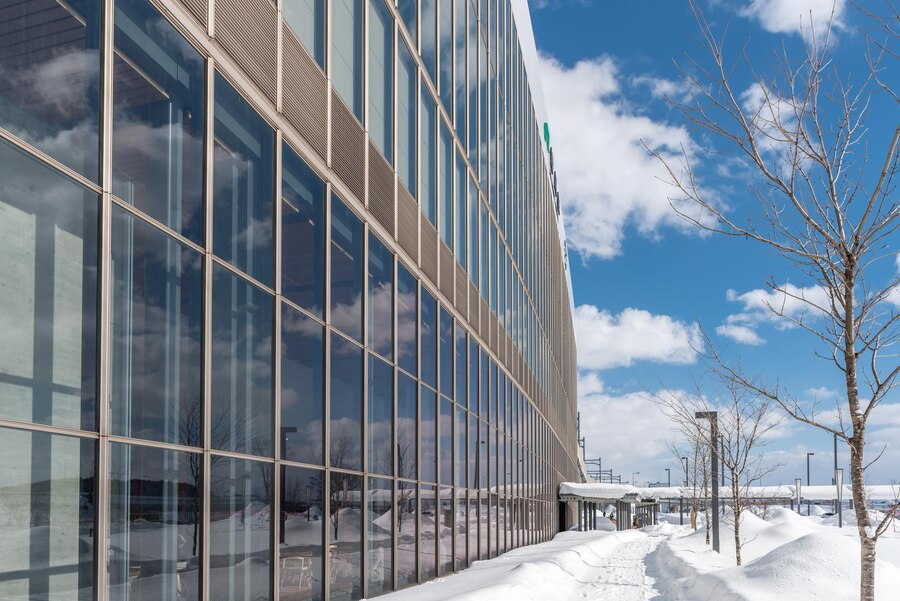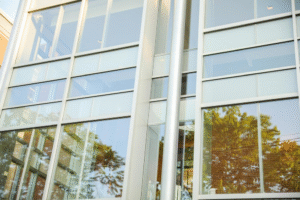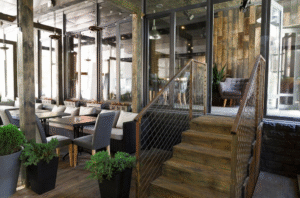
Investing in weatherproof windows and doors now can save you thousands in future maintenance, energy bills, and structural repairs. Prevention is smarter than correction.
The consequences of not preparing commercial buildings for extreme weather are quickly apparent: leaks, insulation problems, mold, structural damage, and rising energy costs. In many cases, the root of the problem is simple: low-quality or climate-inappropriate doors and windows.
This explores how to avoid those setbacks. We’ll help you choose the best weatherproof windows and doors for each climate, whether you’re building in an area with freezing winters, scorching heat, high humidity or frequent storms.
From materials and design features to cutting-edge technology, you’ll learn what makes the difference between constant repairs and long-term performance.
Ready to protect your project from day one? Let’s get into it.
What are weatherproof windows and doors?
Not all materials are built the same. The difference between “standard” and weatherproof windows and doors in commercial construction can mean years of costly issues.
Weatherproof windows and doors are specifically engineered to withstand harsh environmental conditions without compromising structural integrity, energy efficiency, or safety.
That means they’re designed to resist heavy rain, intense sun, strong winds, snow, humidity, and even temperature swings.
Here’s what typically makes a window or door weatherproof:
Reinforced materials
High-grade aluminum, fiberglass, or composite frames engineered to resist warping, corrosion, and thermal transfer. Fluctuations in temperature, humidity, and UV exposure can break down standard materials over time in commercial buildings, causing misalignment, frame swelling, and even structural gaps.
Reinforced materials are designed to maintain form and function under stress. Aluminum, for example, offers strength without bulk, and when thermally broken, it blocks conductive heat flow.
Fiberglass and composite frames deliver high dimensional stability, resisting rot, rust, and expansion even in coastal or high-moisture zones. These materials also require less maintenance, making them ideal for long-term projects.
Multi-layered glass
Double or triple-pane glazing goes beyond basic insulation. These units are built with multiple sheets of glass separated by insulating gas fills like argon or krypton, which slow thermal transfer between the building’s interior and exterior.
Additionally, low-E coatings (low emissivity) are applied to the glass to reflect infrared heat and block up to 99% of UV rays, preserving interior finishes, reducing glare, and boosting energy performance.
In commercial environments with large window spans, multi-layered glass improves comfort, light control, and efficiency without compromising aesthetics.
Sealed edges and gaskets
Advanced sealing systems are one of the most essential components of weatherproof windows and doors. Even high-end frames and glass will underperform without proper edge sealing and durable gaskets.
Modern designs include multi-point compression seals, dual-layer weatherstripping, and pressure-equalized drainage channels—all working together to block air, moisture, and sound.
These systems also prevent mold, condensation, and energy leakage, which are critical in commercial settings where climate control is constant.
Impact resistance
It is crucial to protect the interior of a building against airborne debris and abrupt shifts in pressure when an area is susceptible to storms.
Impact-resistant windows and doors use laminated safety glass, typically constructed by bonding two or more layers of glass with a resilient interlayer like PVB (polyvinyl butyral).
Even if shattered, this glass remains adhered to the interlayer, reducing the risk of injury, interior damage, or building pressurization issues. Combined with heavy-duty frames, reinforced locking systems, and proper anchoring, these products become a must for commercial buildings in coastal or high-risk areas.
Weatherproof windows and doors are safeguards for your commercial project.
Why weatherproof windows and doors are essential in commercial projects
The weather is unpredictable. Your building’s performance shouldn’t be.
Weatherproof windows and doors are essential in ensuring the long-term durability, safety, and efficiency of any commercial project.
Durability
Doors and windows are among the most exposed elements of any commercial building.
Daily exposure to sun, rain, wind, and temperature swings takes a toll and when products are poorly designed or improperly installed, the toll shows up fast. Warping frames, deteriorating seals, corrosion, and even structural failure appear.
Weatherproof units, however, are built to last. Engineered with materials like reinforced aluminum, fiberglass, and composite frames, they resist moisture absorption, UV degradation, and thermal expansion.
That means fewer repairs, longer service life, and far less downtime for building maintenance teams, especially in high-traffic environments where reliability is non-negotiable.
Energy efficiency
Climate control is one of the most significant ongoing expenses in any commercial facility. When windows and doors aren’t optimized for performance, buildings lose heated or cooled air, forcing HVAC systems to work harder and consume more energy.
High-performance glazing, insulated frames, and tight seals help maintain consistent indoor temperatures, improve thermal regulation, and reduce energy waste.
This translates into lower monthly utility bills, less stress on mechanical systems, and long-term savings that often outweigh the initial investment in weatherproof components. These savings can easily scale into thousands of dollars annually in large-scale buildings.
Safety and structural integrity
In regions prone to severe weather, standard solutions simply aren’t enough. Ordinary glass can shatter. Weak seals can leak. Those failures affect comfort and impact structural integrity.
Weatherproof windows and doors are designed to resist impact, flex with pressure changes, and seal out water, wind, and debris. They reduce the risk of interior damage, mold formation, and costly insurance claims by protecting the building envelope.
Code compliance
Building codes are evolving fast. Today, developers and contractors must meet higher standards for energy performance, wind resistance, and environmental resilience. Failing to comply can mean delays, fines, forced retrofits, and even revoked occupancy permits.
That’s why using certified weatherproof windows and doors is no longer optional, it’s strategic. These products are tested and approved under strict industry standards (like ENERGY STAR®), ensuring your project meets local and national requirements.
The right materials and certifications are critical, but so is choosing the right solution for your climate zone. The following section breaks down the best weatherproof windows and doors for each type of environment.
Best weatherproof windows and doors for different climates

Cold climates
Problem: Heat loss, condensation, and freezing.
Best solution:
- Triple-pane or double-pane insulated glass with argon or krypton gas for thermal performance.
- Thermally broken aluminum or composite frames to prevent heat transfer.
- Low U-factor ratings for maximum insulation.
Why it works: These features trap indoor heat, prevent condensation on the glass, and stop cold drafts from compromising interior comfort.
Hot and sunny climates
Problem: Heat gain, fading interiors, overworked HVAC systems.
Best solution:
- Low-E (low emissivity) glass coatings to reflect infrared and UV rays.
- Tinted or reflective glazing to reduce solar heat gain.
- Light-colored frames that absorb less heat.
Why it works: These components reduce solar penetration, keeping interiors cooler and energy bills lower—especially during peak summer months.
High-wind or storm-prone areas
Problem: Impact damage, water infiltration, safety hazards.
Best solution:
- Impact-resistant laminated glass that meets hurricane/temporal zone codes.
- Heavy-duty framing systems with reinforced seals and anchoring.
- Multi-point locking mechanisms for added structural security.
Why it works: These systems are designed to withstand flying debris, intense pressure changes, and driving rain—minimizing damage and maximizing occupant safety.
Humid or coastal regions
Problem: Corrosion, mold, swelling, and frame deterioration.
Best solution:
- Fiberglass or composite frames that resist rot, warping, and salt air.
- Anti-corrosion hardware (stainless steel or powder-coated components).
- High-performance weatherstripping to prevent moisture intrusion.
Why it works: These materials are non-porous and durable, designed to withstand constant moisture exposure without breaking down or losing performance.
Modern technologies in weatherproof windows and doors for climate protection
Today’s weatherproof windows and doors go far beyond basic seals and insulation. Thanks to innovation, modern commercial projects now have access to advanced technologies that enhance durability, energy efficiency, and climate adaptability.
Here are the key technologies making a real impact:
Advanced sealing systems
High-performance weather stripping and compression seals prevent air and water infiltration even under extreme pressure. These systems reduce the risk of drafts, moisture buildup, and energy waste.
Smart glass & Low-E coatings
Low-E glass reflects infrared and UV rays, improving thermal control while protecting interiors from fading. Some systems go further with electrochromic smart glass, which automatically tints based on sunlight, reducing heat gain without blinds or films.
Pressure-equalized rain screens
Integrated into window and door assemblies, these systems manage moisture by equalizing air pressure and draining water before it reaches the structure. Ideal for high-rain or coastal zones.
Photovoltaic glass (PV glass)
This technology turns windows into energy-generating surfaces. While not yet mainstream, PV glass can help offset energy costs and support LEED certifications in green building projects.
Automated ventilation controls
Automated systems adjust airflow and seal tightness of doors and windows in large commercial buildings based on indoor/outdoor conditions—balancing comfort, humidity, and energy consumption in real time.
These innovations are performance upgrades that give your project a competitive edge in efficiency, compliance, and longevity.
How to choose the right supplier for weatherproof windows and doors

Even the best weatherproof windows and doors won’t perform if they’re poorly sourced.
Choosing the right supplier is just as important as choosing the right materials, especially for commercial projects where failure isn’t an option.
Here’s what to look for:
Proven track record in commercial projects
Prioritize those with a history of successful commercial installations, particularly in climate zones similar to yours. Ask for case studies, project portfolios, and client references.
A solid track record reflects consistency, experience under pressure, and a deeper understanding of real-world performance.
Certified products and materials
Quality isn’t subjective, it’s measurable. Reliable suppliers should offer products that meet or exceed industry benchmarks for performance, safety, and energy efficiency.
Full-service support
The best suppliers are your partners. That means they provide end-to-end support, from product selection and specification to post-installation troubleshooting.
You want a supplier who will:
Offer site-specific recommendations
Provide technical documentation and compliance reports
Be available for on-site assessments and installer training
Back their products with robust warranties and post-sale support
This level of engagement reduces errors, delays, and long-term risk.
Customization and scalability
Whether you’re designing a medical facility, retail space, or high-rise office, your supplier should offer:
Custom dimensions and shapes
Material and finish variety to match your aesthetic and performance needs
Hardware compatibility for smart locks, access control, and automation
And most importantly, the production and delivery capacity to scale with your project
customization should be seamless.
Transparency and communication
Late shipments, unclear specifications, or poor follow-up can derail even the best-planned build.
Choose suppliers who:
Provide clear, itemized quotes
Set realistic, trackable delivery timelines
Maintain open channels for updates and technical clarification
A communicative supplier is often the difference between a smooth install and a missed deadline.
A great product is only as good as the team behind it. By vetting your supplier with these criteria, you ensure that your investment in weatherproof windows and doors comes with the service, support, and peace of mind your commercial project demands.
Ready to invest in weatherproof windows and doors?
Investing in weatherproof windows and doors is about building smarter, safer, and more cost-efficient structures from the ground up.
You ensure your commercial project meets today’s performance demands while staying protected long into the future by choosing the right materials, leveraging modern technology, and partnering with experienced suppliers.
The right products will minimize maintenance, maximize energy efficiency, and keep occupants safe and comfortable.
Ready to upgrade your project with high-performance weatherproof windows and doors?
Explore Top Notch Remodeling’s website and schedule a consultation today.



